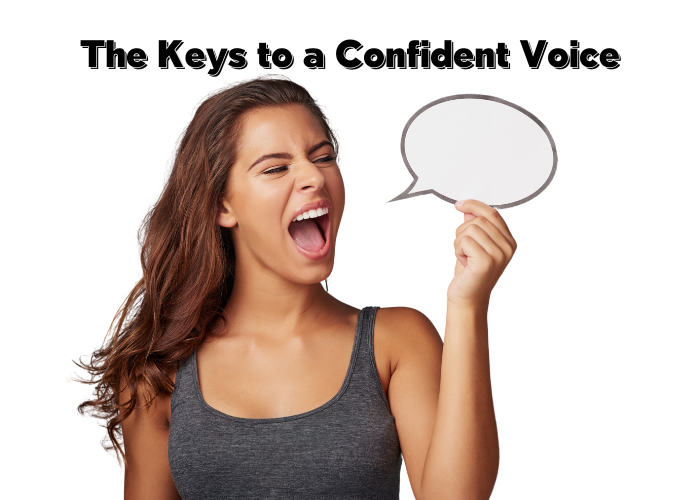A voice coach’s guide to unleashing your inner power.
Confidence—we all want it, some of us have it, and others are desperately trying to find it. Whether it’s a big speaking gig, a poignant conversation at work, or heart-to-hearts at home, the truth remains the same: Confidence is not an exclusive trait, but a skill accessible to all, and with the right tools, you can harness it when it truly matters.
As a voice coach and seasoned vocalist with over 20 years of experience, I’ve witnessed numerous success stories in the realm of confidence-building. Here, I’ll unpack the voice-confidence link and unveil answers that may surprise you with their simplicity.
The Correlation Between Voice and Confidence
Within seconds, your audience will form impressions of your confidence, and a large part of that decision is based on your vocal attributes. The good news? Evidence suggests there are strategies to project confidence and competence, regardless of internal nervousness or timidity.
Perhaps the simplest way to kick off this voice-confidence conversation is to talk tone. The concept of tone (i.e., the quality of sounds we make) becomes paramount in this discussion, as recent studies suggest that a person’s voice may matter twice as much as the content conveyed. Qualities like roughness, strain, or breathiness in a voice may project negativity, weakness, passivity, or tension. Conversely, open and full voices (rich, resonant, warm/bright, velvety) are associated with confidence, dominance, and assurance.
In this Toastmasters Podcast episode, vocal coach Jillian Mitchell shares tips for unblocking your voice to improve its quality and even guides the co-hosts through a fun vocal exercise.
Voice Work for Enhanced Confidence
Your voice is an instrument—do you know how to “play” it efficiently, or even how it works? By developing competence in your instrument, you’ll not only feel more confident, but you’ll be empowered to skillfully course-correct to your desired expression. In other words, you’ll have a choice in the sounds you make.
An open and free tone is the result of harmonious collaboration among the respiratory (air), phonatory (voice box), and resonatory (chest, throat, head) systems. If you’re not experiencing an open, free tone it’s a cue that your voice is being blocked, likely by learned habits. Vocal work, particularly regular warm-ups, gets us out of those habits and into our full, resonant, and confident voices.
Confidence is not an exclusive trait, but a skill accessible to all, and with the right tools, you can harness it when it truly matters.
Whether it’s a wedding toast, eulogy, or morning board meeting—don’t let your first vocalization of the day be in a high-stakes situation. The voice is a muscle like any other, and muscles benefit from being warmed up. Though daily warm-ups are ideal, penciling one in before those key conversations and presentations will do the trick. And it’ll make all the difference (think: no morning voice or incessant throat clearing). For an easy warm-up, check out 5 Exercises to Vocal Tone. (And be sure to drink your water! A dehydrated voice is a scratchy tired voice.)
Next—become friends with the sounds you make. Don’t mistake this for egotistical; it’s self-confidence. While your warm-up builds trust with your voice, this process builds self-acceptance. Together, it’s a combination that fosters the competence-confidence loop: competence in your vocal ability, and confidence not only in the sounds you make, but in putting your voice out there when it counts. Record yourself, listen back, and build upon the good.
https://www.youtube.com/embed/0bcliyEndTg?si=oibDRJmRfpB8CWDb&enablejsapi=1&origin=https%3A%2F%2Fwww.toastmasters.org
Dealing With Nerves in Awkward Conversations
Elevated heart rate, shortness of breath, racing thoughts—when nerves strike, the initial casualty is often our breath, the very foundation required for a confident and composed voice. The solution? Breathe. But it’s not always that simple, and sometimes a reframe is needed before you can access that breath.
Nerves, acting as a silent attribute, emulate distinctive vibes to our listeners, subtly influencing the atmosphere and setting the tone of our communication. And often, nerves get a bad rap. But what if I told you that nerves can be reframed, as excitement without the breath? This helps shape a positive atmosphere for your listeners through the concept of co-regulation. Your vibe affects their vibe, and vice versa—here’s how to use it to your advantage:
- Reframe it: Anxiety or excitement—you choose.
- Breathe: There’s a great quote from psychologist Paul Ekman, who says, “The most powerful person in the room is the one who’s breathing.” He’s not wrong. We need breath to support a confident voice. Here’s a simple exercise: Beforehand, take three deep breaths (an inhale followed by an exhale, three times), and extend the exhale twice as long as the inhale. During the conversation, do your best to breathe; create a mantra or visual cue as a reminder.
- Resist the urge to judge: We all get nervous. And some of us never outgrow it. The trick is to resist getting into a mental narrative about it.
- Give it 90: There’s exciting research that says emotions will dissipate in 90 seconds if you practice three steps: identify it, label it, and observe it without trying to change it.
- Actively listen: Resist formulating your next thought. Pause before you react. Be intentional with your words. That will bring confidence to the game.
- Use “I” language: When you focus on yourself and how you feel, it comes across as constructive and confident, less accusatory.
- Switch perspective: You don’t look as nervous as you feel. Remember co-regulation.
- Practice: Beforehand, practice what you’re going to say—out loud. And don’t forget your warm-up beforehand! A full, open voice is a confident voice.
- Beware of your beverage: Watch your caffeine intake. Too much can exacerbate nerves, so amp up the water.
Sounding Confident Even When You Don’t Feel It
You’d expect to see the words “fake it till you make it” here, and with good reason. But to me, confidence is not a destination, it’s a journey, and though it ebbs and flows with the situation, it’s always accessible—and some of us may need a minute to access it.
Here are a few more tips to get you on the confidence track:
- Change the way you think about failure. Mistakes are okay.
- Change your motivation for being there, from convincing to sharing.
- Don’t compare yourself to others.
- How you talk to yourself matters. If positive self-talk doesn’t come naturally, try adopting a neutral way of speaking, one that’s constructive and less judgmental.
- Eliminate filler words like “um” and “ah.”
- Take time to pause; silence is an effective tool.
- Vary your vocal variety and pace of delivery.
- Be authentic. Bring value to the conversation.
- Body language counts. Make eye contact, keep an open posture, and use gestures meaningfully.
- Stay present. You don’t look as anxious as you feel.
- Practice in front of others, or the mirror. Become familiar with what you look like when you speak and exercise self-acceptance.
- Manage nerves. Nerves stem from “what ifs” or uncertainties. Quash these doubts. Visit the venue beforehand. Play out the scenario. Refer to the tips in the previous section.
- Prepare. A lack of a clear message undermines your confidence.
- Record yourself, if possible, and listen back for cohesion and confidence.
Imagine giving a speech where the power and warmth of your voice captivates the audience, leaving a lasting impression. Where you’re addressing colleagues in the workplace or presenting ideas to your manager with authority and competence, garnering respect from peers. Where heart-to-hearts at home happen regularly and with more ease.
By incorporating these insights and tools into your daily life, you, too, can access and project confidence whenever the need arises. Remember, your voice is not just a means of communication; it is a powerful instrument that, when mastered, can open doors to newfound confidence in every aspect of your life.
This article has been published by Toastmaster Magazine by Jillian Mitchell

